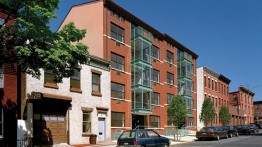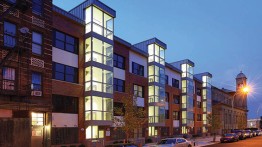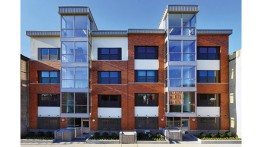Filling in the Gaps
POSTED ON: April 16, 2021
Affordable housing—a perennial problem in New York City that has proven even more urgent with the COVID-19 emergency—raises tough questions: how do we define “affordable”? What form should it take? And frequently the most contentious of all—where should it be located? Last October, Mayor Bill de Blasio announced a plan to build 800 new units in the New York neighborhood of SoHo, a highly unusual move considering the wealth of the proposed location. Besides signaling an attempt at spreading affordable housing equitably across the city, it’s also a response to growing homelessness, which according to a study conducted by the city, rose by 7% from January 2019 to January 2020. The numbers have almost certainly grown since then, but as CityLab has reported, the COVID crisis has posed multiple obstacles to getting an accurate count of just how many people have lost their homes in the past year.

The issue has been central to Carmi Bee, a principal of RKTB Architects and a 1967 Cooper Union graduate who served as an alumni trustee on Cooper’s Board of Trustees from 2002 to 2006 and as CU Alumni Council president from 2007 to 2009. This past January, he told the Architect’s Newspaper that he hopes the Biden Administration will address the housing crisis in thoughtful, holistic ways since “people need more than shelter—they need healthy, permanent homes in thriving communities.” In August 2020, he published an article in ArchNewsNow arguing that architects have a responsibility to plan for maximum health and safety for their clients, a mandate made urgent by the pandemic. His essay draws apt parallels between architectural responses to early 20th century concerns about fire and disease and today’s rising sea levels, future epidemics, and how to design for those eventualities. In the piece, he describes a potential solution to some of New York’s housing woes in the form of infill housing, new structures in spaces where there's either an empty lot or a derelict building. The term implies a building of approximately the same height and width of adjacent buildings that will not contradict the architectural character of the neighborhood. RKTB has built its own Infill Housing Prototype© at sites across Brooklyn on lots zoned as R-6, which can hold small, multifamily apartment buildings 20–25 feet wide. The form could be one tool for addressing New York’s ever-pressing housing crisis—one clearly exacerbated in 2020—as a strategy for filling voids in a neighborhood—replacing “what I call missing teeth,” he says. Ideally two adjacent lots could be used to create an eight-unit building.
The prototype is purposely simple: four- to five-story buildings with a floor plate of 2,500 square feet of usable space, no elevator, flexible apartment plans, and a well-lit glazed central stairwell visible from the street. The aim is to keep costs down and provide solidly built spaces that can be modified for different uses. The stairwell also gives residents greater security and less opportunity to be in close quarters with neighbors as happens in elevators. “The problem with walkways,” Bee says, “is that they’re often hidden away, and dark and depressing,” and frequently unsafe. “That was a very important factor” in the building design, Bee says, because essential to the prototype is its promotion of community safety. The first-floor apartments of the buildings are accessible.
The Infill Housing Prototype, it turns out, has long roots that lead back to Bee’s days as an undergraduate where he studied under John Hejduk, the architecture school’s first dean, renowned for his approach to architecture pedagogy. “He was a formalist but a poet on top of that so without being overt he was quite political.” While studying an unrealized development plan for the town of Hook in Hampshire, U.K. by the London County Council, Bee created a matrix of activities for analyzing the needs of the town. Hejduk loved the approach, so for his thesis project, Bee applied his ideas to a renewal scheme for the East Village. Bee is quick to point out that his plans had nothing to do with urban renewal—the euphemistic term for razing low-income neighborhoods. Instead, he proposed a design centered on infill housing that would be introduced incrementally. Hejduk along with Bernard Rothzeid, Bee’s mentor and later partner at RKTB, encouraged him to reach out to a local organization, Mobilization for Youth in the East Village, to get their input. Speaking with the group helped solidify his belief that neighborhood organizers and residents must be involved. Bee went on to earn his Master in Architecture at Princeton, deciding that his career’s focus would be using architecture to improve communities.
He eventually joined Rothzeid’s firm and became partner in 1981. The firm was and remains an environment that encourages the concept of architecture as a form of social justice. In those first years, Bee worked on housing renovations in Washington Heights, Hell’s Kitchen, sites around Brooklyn—all of which brought him back to his thesis project, which had the potential to act as connective tissue in communities where public housing had often been built with little consideration—and at times clear contempt—for residents and the surrounding neighborhood.
Bee started to collaborate with Michael Lappin, then the president of the Community Preservation Corporation (CPC). The group was founded in 1974 in response to the extraordinary number of apartments lost to fire, neglect, or demolition—20,000 to 30,000 units per year, according to CPC. Lappin, who still builds affordable housing, teamed up with Bee to build the prototype in multiple iterations but with the same essential elements. As he put it in his August article, “Our investigations for remediating these moribund environments began with a commitment to restore both their physical and social fabric.”
Bee and Lappin valued moving incrementally, fortifying neighborhoods lot-by-lot. It was hardly the approach taken by big developers who frequently require large swathes of land to build towers that almost always clash with a neighborhood’s scale and style. Bee, who characterizes tabula rasa urban development as “devastating,” has found that his long-view approach, though slower, is far more valuable to communities than large-scale projects that impose on a neighborhood instead of becoming part of its fabric.
The importance of thinking holistically about affordable housing has also come into focus at The Irwin S. Chanin School of Architecture, particularly since Dean Nader Tehrani introduced a third-year studio sequence dedicated to housing when he came to Cooper in 2015. He echoes Carmi Bee’s philosophy that housing is not a singular entity but a critical piece of the city. “It is housing for us all, and therefore requires communal thinking, compromise, and an understanding of greater social agendas. It is what defines the fabric of the city once we separate out of it the monuments, institutions, and public building. It is the glue that holds cities together.”
According to Professor Mersiha Veledar AR’03, one of the studio’s professors, students learn to consider materials, methods of construction, the high cost of urban real estate plus the need to house as many people as possible without sacrificing quality of housing. Like Bee, Professor Veledar believes it’s important for students “to find novel ways of challenging formal preconceptions through a careful understanding and reconfiguration of typical room standards and their embedded spatial redundancies. We need more availability!”
What Bee began investigating as an aspiring architect at Cooper has proven to be an essential part of his career, yes, but more to the point, a powerful contribution to affordable housing. With many appropriate lots still available, it’s a solution that could have even greater currency as the full effects of the pandemic become painfully clear.







